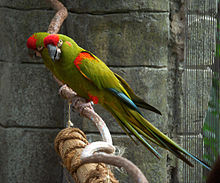Greater Macaws
The greater macaws consist of seven species of macaws, all of which reach 24 inches or more. There are three "green macaws", two "red macaws", and two "blue macaws". These macaws are very often hybridized in captivity, and are the most commonly thought of birds when someone says "macaw".
Blue and Gold Macaw

Ara ararauna ,also known as the blue and gold macaw or the blue and yellow macaw, is one of the two most commonly thought of macaws (the other being the scarlet macaw) and one of the two "blue macaws" in the genus Ara. They can be found across many areas in South America, including Venezuela, Brazil, Bolivia, Colombia, and Paraguay. They can also be found in Panama and Mexico. They are mostly found in tropical rainforests, however can also be found in subtropical forests, savannas, and woodlands. They can reach about 36 inches long, and weigh almost 4 pounds. They are the easiest of the macaws to breed, and because of this are not incredibly expensive. Blue and gold macaws tend to live up to 50 years, and can breed until 35 years of age, however there are reports of these birds living much longer than that. Blue and gold macaws are very common, and are listed as least concern by the IUCN however their numbers are decreasing.
In captivity, blue and gold macaws are perhaps the best pet macaw for beginners. They have a very mild temper, and of course they look amazing. They are also more forgiving of mistakes than other macaws. They are very loving, and great with families, however they will also bond with their owner which makes them one of the best pet macaws.
Sources
2010. "Bird Life International. IUCN Red List of Threatened Species." (On-line). Accessed March 17, 2010 at www.iucnredlist.org.
Juniper, T. 1998. A Guide to Parrots of the World. New Haven: Yale University Press.
Low, R. 1983. Amazon Parrots. London: The Bailisk Press.
Plair, B. 2008. Ornitologia Neotropical. Behavioral monitoring, of Blue-and-yellow Macaws (Ara ararauna) reintroduced to the Nariva Swamp, Trinidad, 19: 113-122.
Ragusa-Netto, J. 2006. Ornitologia Neotropical. Dry fruits and the abundance of the Blue and yellow macaw (Ara ararauna) at a cerrado remnant in central Brazil, 17.4: 491-500.
Macaws - Personality Plus
Blue Throated Macaw

Ara glaucogularis, also known as the blue throated macaw, caninde macaw, and the Wagler's macaw, is a critically endangered species of macaw. They can reach about 33 inches in length, and weigh about 1.5 pounds. The bulk of their diet consists of palm nuts, but they also eat fruits and seeds. They are only found in northern Bolivia. They inhabit palm groves and savannas found in their range.
In captivity, blue throated macaws are very curious macaws, and are definitely the carpenters of the bird world - they have been known to take apart their entire aviary! One of their favorite toys is one that has plenty of knots in it - just be sure to keep tying them up, because they untie them quickly! They are devoting and loving birds, who love attention and will always find a way to get it. They are definitely not recommended to beginning macaw keepers though.
Sources
IUCN Red List (September, 2008)
BirdLife International (2003)
UNEP-WCMC Species Sheets (August, 2003)
CITES (August, 2003)
Loro Parque Fundación (June, 2006)
Asociación Armonía (June, 2006)
Macaws - Personality Plus
Military Macaw
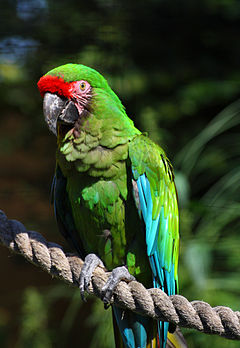
Ara militaris, also known as the military macaw, is a medium-sized macaw that gets its name from its green feathers that resemble a military uniform. They can reach about 28 inches long, and are the "middle child" in the trio of green macaws. They lay their eggs on cliff faces, and two to three eggs are lain in the month of June. They are found sporadically throughout Argentina, Bolivia, Colombia, Ecuador, Mexico, Peru, and Venezuela. They are found in humid forests, foothills, and canyons. They are listed as vulnerable by the IUCN.
In captivity, military macaws are generally nippy birds and definitely not recommended to beginners. They are probably the nippiest of the large macaws, but not the nippiest of all the macaws. They are not all nippy, there are definitely exceptions, but you always want to keep in mind that you're taking a chance when keeping a military. If your macaw is nippy, it can be fixed but takes significant work.
Sources
IUCN Red List (July, 2014)
Macaws - Personality Plus
Buffon's Macaw
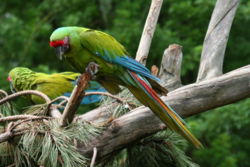
Ara ambiguus, also known as the Buffon's macaw, great green macaw, and the great military macaw, is the largest of the three green macaws. They can reach 36 inches in length and weigh up to 3 pounds. There are two populations of this parrot - one lives in western Ecuador and the other is widespread throughout Honduras and Colombia. They are found in lowland tropical rainforests, the typically thought of habitat for macaws and other tropical parrots. They are listed as endangered by the IUCN.
In captivity, the Buffon's macaw isn't as popular as the military macaw, but they are still more popular than the red-fronted macaw (the other green macaw). Buffon's macaws are also nippers - not as bad as military macaws, but worse than scarlets. Again, there are exceptions but learn the risk you are taking when you keep these birds.
Sources
IUCN Red List (May, 2006)
BirdLife International (August, 2003)
CITES (August, 2003)
Erritzoe, J. (1993) The Birds of CITES and How to Identify Them. The Lutterworth Press, Cambridge.
Macaw Compendium (August, 2003)
Great Green Macaw Research and Conservation Project (August, 2003)
Friends of the Great Green Macaw (August, 2003)
World Parrot Trust (August, 2003)
Macaws - Personality Plus
Scarlet Macaw
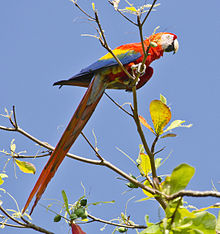
Ara macao, also known as the scarlet macaw, is your stereotypical macaw (along with the blue and gold macaw). They can reach just over 36 inches long, making them one of the largest macaws. Their bright red and yellow colors make them popular to hybridize. Scarlet macaws regularly flock, sometimes with 50 or more birds in one group. They are found pretty much throughout all of Central and South America. They are found in woodlands in savannas, and in tropical lowland rainforests. They are listed as least concern by the IUCN and are perhaps the most common of the macaws.
In captivity, scarlet macaws can be nippers - though not nearly as bad as the military and Buffon's macaws. During the breeding season, these birds are very aggressive. Any other time, these birds are very smart and loving though. They are certainly not for everyone, but if you've got a bit of experience at least with medium to large parrots, the scarlet might make a good pet for you.
Sources
IUCN Red List (September, 2009)
Juniper, T. and Parr, M. (1998) Parrots: A Guide to Parrots of the World. Pica Press, Sussex.
del Hoyo, J., Elliott, A. and Sargatal, J. (1997) Handbook of the Birds of the World. Volume 4: Sandgrouse to Cuckoos. Lynx Edicions, Barcelona.
CITES (September, 2009)
World Parrot Trust - Scarlet Macaw (September, 2009)
Hilty, S.L. and Brown, W.L. (1986) A Guide to the Birds of Colombia. Princeton University Press, Princeton, New Jersey.
Wiedenfeld, D.A. (1994) A new subspecies of scarlet macaw and its status and conservation. Ornitologia Neotropical, 5: 99 - 104.
BirdLife International (September, 2009)
Snyder, N., McGowan, P., Gilardi, J. and Grajal, A. (2000) Parrots: Status Survey and Conservation Action Plan. IUCN, Gland, Switzerland and Cambridge.
Macaws - Personality Plus
Green Winged Macaw
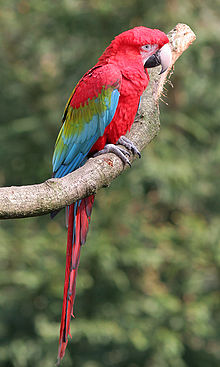
Ara chloropterus, also known as the green winged macaw and the red and green macaw is the second longest parrot, second in size only to the hyacinth macaw - they can reach 37 or 38 inches long, with nearly 5 foot wingspans. They are often mistaken for the brighter scarlet macaw, however green winged macaws have green in place of yellow feathers. These, like the scarlet macaws, are very common birds in the wild, and they are listed as least concern by the IUCN. They are found from Panama southwards, in tropical forests, mangrove swamps, and savannas. They are one of the longest-lived macaws, with an average lifespan of 60 years or over.
In captivity, the green winged macaw is one of the best pet macaws, and the author's personal favorite (with the hyacinth a close second). Green winged macaws are excellent talkers, and are very tolerant of other pets/animals in the household. One of their favorite things to do is just chew on wood - giving them NON PRESSURE-TREATED 2x4's is an easy way to give your bird a toy that will last for quite some time. If you handle and train them well, they will even do well with young children. They are great macaws because when you want to play, they will play; but when you want to just relax, they are happy to do just that.
Sources
Alderton, David (2003). The ultimate encyclopedia of caged and aviary birds. London, England: Hermes House. p. 235.
Animal Diversity Web
Animal World
The BIG Zoo
Forshaw, J.M. Parrots of the World. New Jersey. T.F.H. Publications Inc. 1978.
The IUCN Red List of Threatened Species
Marrison, C. and A. Greensmith. Birds of the World. New York: Dorling Kindersley, Inc. 1993.
Perrins, C. (ed.). The Encyclopedia of Birds. New York: Facts on File Publications. 1985.
Rolling Hills Wildlife Adventure
Macaws - Personality Plus
The greater macaws consist of seven species of macaws, all of which reach 24 inches or more. There are three "green macaws", two "red macaws", and two "blue macaws". These macaws are very often hybridized in captivity, and are the most commonly thought of birds when someone says "macaw".
Blue and Gold Macaw

Ara ararauna ,also known as the blue and gold macaw or the blue and yellow macaw, is one of the two most commonly thought of macaws (the other being the scarlet macaw) and one of the two "blue macaws" in the genus Ara. They can be found across many areas in South America, including Venezuela, Brazil, Bolivia, Colombia, and Paraguay. They can also be found in Panama and Mexico. They are mostly found in tropical rainforests, however can also be found in subtropical forests, savannas, and woodlands. They can reach about 36 inches long, and weigh almost 4 pounds. They are the easiest of the macaws to breed, and because of this are not incredibly expensive. Blue and gold macaws tend to live up to 50 years, and can breed until 35 years of age, however there are reports of these birds living much longer than that. Blue and gold macaws are very common, and are listed as least concern by the IUCN however their numbers are decreasing.
In captivity, blue and gold macaws are perhaps the best pet macaw for beginners. They have a very mild temper, and of course they look amazing. They are also more forgiving of mistakes than other macaws. They are very loving, and great with families, however they will also bond with their owner which makes them one of the best pet macaws.
Sources
2010. "Bird Life International. IUCN Red List of Threatened Species." (On-line). Accessed March 17, 2010 at www.iucnredlist.org.
Juniper, T. 1998. A Guide to Parrots of the World. New Haven: Yale University Press.
Low, R. 1983. Amazon Parrots. London: The Bailisk Press.
Plair, B. 2008. Ornitologia Neotropical. Behavioral monitoring, of Blue-and-yellow Macaws (Ara ararauna) reintroduced to the Nariva Swamp, Trinidad, 19: 113-122.
Ragusa-Netto, J. 2006. Ornitologia Neotropical. Dry fruits and the abundance of the Blue and yellow macaw (Ara ararauna) at a cerrado remnant in central Brazil, 17.4: 491-500.
Macaws - Personality Plus
Blue Throated Macaw

Ara glaucogularis, also known as the blue throated macaw, caninde macaw, and the Wagler's macaw, is a critically endangered species of macaw. They can reach about 33 inches in length, and weigh about 1.5 pounds. The bulk of their diet consists of palm nuts, but they also eat fruits and seeds. They are only found in northern Bolivia. They inhabit palm groves and savannas found in their range.
In captivity, blue throated macaws are very curious macaws, and are definitely the carpenters of the bird world - they have been known to take apart their entire aviary! One of their favorite toys is one that has plenty of knots in it - just be sure to keep tying them up, because they untie them quickly! They are devoting and loving birds, who love attention and will always find a way to get it. They are definitely not recommended to beginning macaw keepers though.
Sources
IUCN Red List (September, 2008)
BirdLife International (2003)
UNEP-WCMC Species Sheets (August, 2003)
CITES (August, 2003)
Loro Parque Fundación (June, 2006)
Asociación Armonía (June, 2006)
Macaws - Personality Plus
Military Macaw

Ara militaris, also known as the military macaw, is a medium-sized macaw that gets its name from its green feathers that resemble a military uniform. They can reach about 28 inches long, and are the "middle child" in the trio of green macaws. They lay their eggs on cliff faces, and two to three eggs are lain in the month of June. They are found sporadically throughout Argentina, Bolivia, Colombia, Ecuador, Mexico, Peru, and Venezuela. They are found in humid forests, foothills, and canyons. They are listed as vulnerable by the IUCN.
In captivity, military macaws are generally nippy birds and definitely not recommended to beginners. They are probably the nippiest of the large macaws, but not the nippiest of all the macaws. They are not all nippy, there are definitely exceptions, but you always want to keep in mind that you're taking a chance when keeping a military. If your macaw is nippy, it can be fixed but takes significant work.
Sources
IUCN Red List (July, 2014)
Macaws - Personality Plus
Buffon's Macaw

Ara ambiguus, also known as the Buffon's macaw, great green macaw, and the great military macaw, is the largest of the three green macaws. They can reach 36 inches in length and weigh up to 3 pounds. There are two populations of this parrot - one lives in western Ecuador and the other is widespread throughout Honduras and Colombia. They are found in lowland tropical rainforests, the typically thought of habitat for macaws and other tropical parrots. They are listed as endangered by the IUCN.
In captivity, the Buffon's macaw isn't as popular as the military macaw, but they are still more popular than the red-fronted macaw (the other green macaw). Buffon's macaws are also nippers - not as bad as military macaws, but worse than scarlets. Again, there are exceptions but learn the risk you are taking when you keep these birds.
Sources
IUCN Red List (May, 2006)
BirdLife International (August, 2003)
CITES (August, 2003)
Erritzoe, J. (1993) The Birds of CITES and How to Identify Them. The Lutterworth Press, Cambridge.
Macaw Compendium (August, 2003)
Great Green Macaw Research and Conservation Project (August, 2003)
Friends of the Great Green Macaw (August, 2003)
World Parrot Trust (August, 2003)
Macaws - Personality Plus
Scarlet Macaw

Ara macao, also known as the scarlet macaw, is your stereotypical macaw (along with the blue and gold macaw). They can reach just over 36 inches long, making them one of the largest macaws. Their bright red and yellow colors make them popular to hybridize. Scarlet macaws regularly flock, sometimes with 50 or more birds in one group. They are found pretty much throughout all of Central and South America. They are found in woodlands in savannas, and in tropical lowland rainforests. They are listed as least concern by the IUCN and are perhaps the most common of the macaws.
In captivity, scarlet macaws can be nippers - though not nearly as bad as the military and Buffon's macaws. During the breeding season, these birds are very aggressive. Any other time, these birds are very smart and loving though. They are certainly not for everyone, but if you've got a bit of experience at least with medium to large parrots, the scarlet might make a good pet for you.
Sources
IUCN Red List (September, 2009)
Juniper, T. and Parr, M. (1998) Parrots: A Guide to Parrots of the World. Pica Press, Sussex.
del Hoyo, J., Elliott, A. and Sargatal, J. (1997) Handbook of the Birds of the World. Volume 4: Sandgrouse to Cuckoos. Lynx Edicions, Barcelona.
CITES (September, 2009)
World Parrot Trust - Scarlet Macaw (September, 2009)
Hilty, S.L. and Brown, W.L. (1986) A Guide to the Birds of Colombia. Princeton University Press, Princeton, New Jersey.
Wiedenfeld, D.A. (1994) A new subspecies of scarlet macaw and its status and conservation. Ornitologia Neotropical, 5: 99 - 104.
BirdLife International (September, 2009)
Snyder, N., McGowan, P., Gilardi, J. and Grajal, A. (2000) Parrots: Status Survey and Conservation Action Plan. IUCN, Gland, Switzerland and Cambridge.
Macaws - Personality Plus
Green Winged Macaw

Ara chloropterus, also known as the green winged macaw and the red and green macaw is the second longest parrot, second in size only to the hyacinth macaw - they can reach 37 or 38 inches long, with nearly 5 foot wingspans. They are often mistaken for the brighter scarlet macaw, however green winged macaws have green in place of yellow feathers. These, like the scarlet macaws, are very common birds in the wild, and they are listed as least concern by the IUCN. They are found from Panama southwards, in tropical forests, mangrove swamps, and savannas. They are one of the longest-lived macaws, with an average lifespan of 60 years or over.
In captivity, the green winged macaw is one of the best pet macaws, and the author's personal favorite (with the hyacinth a close second). Green winged macaws are excellent talkers, and are very tolerant of other pets/animals in the household. One of their favorite things to do is just chew on wood - giving them NON PRESSURE-TREATED 2x4's is an easy way to give your bird a toy that will last for quite some time. If you handle and train them well, they will even do well with young children. They are great macaws because when you want to play, they will play; but when you want to just relax, they are happy to do just that.
Sources
Alderton, David (2003). The ultimate encyclopedia of caged and aviary birds. London, England: Hermes House. p. 235.
Animal Diversity Web
Animal World
The BIG Zoo
Forshaw, J.M. Parrots of the World. New Jersey. T.F.H. Publications Inc. 1978.
The IUCN Red List of Threatened Species
Marrison, C. and A. Greensmith. Birds of the World. New York: Dorling Kindersley, Inc. 1993.
Perrins, C. (ed.). The Encyclopedia of Birds. New York: Facts on File Publications. 1985.
Rolling Hills Wildlife Adventure
Macaws - Personality Plus


